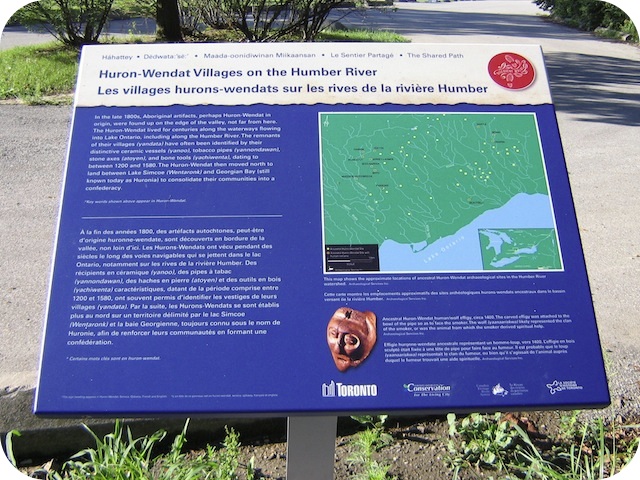Discover Toronto's history as told through its plaques
2004 - Now in our 14th Year - 2018
To see what's new on this site, you can visit the Home Page
Looking at this page on a smartphone?
For best viewing, hold your phone in Landscape mode (Horizontal)
Huron-Wendat Villages on the Humber River

Photos by Alan L Brown - Posted August, 2011



This Story Circle, the eighth of 13 story circles on the "Discovery Walks - The Shared Path", can be found in Humber Marshes Park where the car road ends and the pedestrian path begins. Here's what the plaques say:
Coordinates: 43.643756 -79.492693 |
 |
In the late 1800s, Aboriginal artifacts, perhaps Huron-Wendat in origin, were found up on the edge of the valley, not far from here. The Huron-Wendat lived for centuries along the waterways flowing into Lake Ontario, including along the Humber River. The remnants of their villages have often been identified by their distinctive ceramic vessels, tobacco pipes, stone axes, and bone tools, dating to between 1200 and 1580. The Huron-Wendat then moved north to land between Lake Simcoe and Georgian Bay (still known today as Huronia) to consolidate their communities into a confederacy.
The Huron-Wendat were accomplished traders with extensive networks throughout northeastern North America and beyond. They made contact with the French in 1609, and welcomed the first of many French visitors, Étienne Brûlé, to southern Ontario in 1610.
Approaching a Huron-Wendat village, French travellers encountered well-tended fields of corn, beans, and squash. Agriculture, supplemented by fishing, gathering, and hunting, allowed some Huron-Wendat villages to grow to nearly 2,000 people. Surrounded by fields and situated near rivers or creeks, villages of longhouses were positioned to command a view over the surrounding territory, and were sometimes surrounded by a palisade to protect their inhabitants.
Huron-Wendat use of the Carrying Place trail along the Humber River likely became occasional after 1600, as this route was threatened by their enemies, the Five Nations Iroquois. Displaced from their homeland by 1650, many Huron-Wendat moved to the Quebec City area where they remain today. While urban development has since destroyed many of their former village sites on the Humber, traces of these settlements may still be found in the yards and gardens that border the river.
Shared Path Story Circles Information and Map
Discovery Walks - The Shared Path
Related webpages
The Humber River
Huron-Wendat
Carrying Place trail
Five Nations Iroquois
Related Toronto plaques
Étienne Brûlé
Toronto's Huron-Wendat Heritage
Links to all the other Story Circles
#1 Discover the Humber River's Ancient Past
#2 Toronto Carrying Place
#3 Railways Over the Humber
#4 Roads over the Humber River
#5 Boating on the Humber River
#6-1 The Beginnings of French Toronto
#6-2 The Rousseaux Family and Early Toronto
#6-3 Jean-Baptiste Rousseaux 1758-1812
#7 Humber River Marshes and Oak Savannah
#9 Hurricane Hazel
#10 The King's Mill
#11 Teiaiagon and the Aboriginal Occupation of Baby Point
#12 Dundas Street Crossing and Lambton Mills
#13 Mississauga Settlements on the Humber River
Here are the visitors' comments for this page.
(none yet)
Here's where you can sent me a comment for this page.
Note: Your email address will be posted at the end of your comment so others can respond to you unless you request otherwise.
Note: Comments are moderated. Yours will appear on this page within 24 hours (usually much sooner).
Note: As soon as I have posted your comment, a reply to your email will be sent informing you.
To send me your comment, click [email protected].
Thanks
Webmaster
Note: If you wish to send me a personal email, click here.